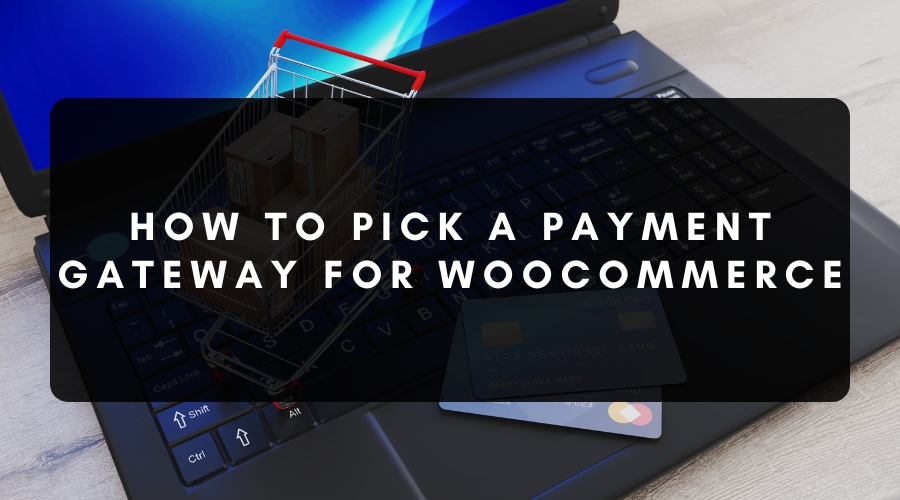
How to Pick the Best Payment Gateway for WooCommerce
Prioritise compatibility, security, supported payment methods, transparent pricing, ease of use, and customer support when selecting the best payment gateway for your WooCommerce store. These factors ensure smooth checkouts, meet customer preferences, and support store growth.
A payment gateway for WooCommerce integrates directly with your WooCommerce store—literally acting as the gateway to accept electronic online transactions. It encrypts sensitive customer data to ensure security while communicating with a payment processor that verifies and transfers the funds from the customer’s bank account to your business account.
Selecting the best WooCommerce payment gateway requires a thoughtful, systematic approach that considers your business’s needs, customer preferences, and the technical requirements of your store. The following steps will help you make an informed decision.
1. Analyse Your Business Requirements
Start by identifying key requirements for your store:
- What payment methods do your target customers prefer?
- Do you need features like recurring billing or subscriptions for your products or services?
- What is your monthly transaction volume?
- Do you require the ability to accept multiple currencies? (If so, opt for a global payment gateway.)
Understanding these requirements will help you narrow down the list of payment gateways and payment processors that best align with your store’s needs.
2. Review WooCommerce Compatibility and Integration
A seamless integration with WooCommerce is key to reducing technical issues and ensuring smooth operations. Look for a payment gateway that offers:
- Dedicated WooCommerce Plugin: A plugin designed specifically for WooCommerce minimises setup time and ensures reliable performance.
- Shopping Cart Integration: A WooCommerce-compatible payment gateway ensures seamless integration and service provision.
- Ease of Setup: Look for gateways that provide clear instructions and easy installation processes. Consider platforms that offer integration support to guide you through the setup process.
- Compatibility With Other Plugins and Themes: The best WooCommerce payment gateways work with other essential WooCommerce plugins like inventory management, SEO tools, and marketing integrations to simplify e-commerce business management.
- Automatic Updates: Choose gateways that update automatically to remain compatible with the latest WooCommerce versions.
3. Evaluate Security Features
A secure gateway is paramount because it protects your business and customers from fraud and data breaches. Look for these essential security features:
- PCI DSS Compliance: Level 1 PCI compliance ensures your payment gateway adheres to the most stringent security standards for data protection.
- Fraud Detection Tools: Look for advanced tools that detect and prevent fraudulent transactions in real-time, such as flagging suspicious activities like multiple failed payments.
- Data Encryption and Tokenisation: Encryption secures sensitive data during transactions, while tokenisation replaces customer data with a unique token to protect against theft.
4. Check Regional Availability
Confirm that the payment gateway supports the regions where you operate. Some gateways may have geographic or regulatory limitations, so it’s essential to choose one that aligns with your market and operational needs.
5. Review the Supported Payment Methods
According to Statista, 17% of online shoppers abandon their carts when their preferred payment method isn’t supported, emphasising the importance of offering diverse and convenient online payment options to improve conversions. Look for gateways that support:
- Major Credit and Debit Cards: Visa, Mastercard, American Express, and other widely recognised cards should be accepted.
- Mobile Payments: Integrating mobile payment options provides convenient, secure options for mobile shoppers.
- Local Payment Methods: Support local payment methods and currencies to boost conversions.
- Bank Transfers and Direct Debits: Offering alternative payment methods like bank transfers, direct debits, QR codes, e-cheques, e-cash, and cryptocurrencies enhances flexibility, especially for larger transactions.
6. Ensure Smooth Currency Conversion
Managing currency conversions effectively is essential if you plan to sell internationally. Look for:
- Transparent Conversion Rates: Avoid inflated rates that could surprise customers and harm your profit margins.
- Multi-Currency Payment Gateway: Choose a multi-currency payment gateway that allows customers to transact in local currencies for a better experience.
- Integrated Currency Tools: Choose gateways with tools to simplify currency conversion and reporting, allowing you to manage international payments with ease.
7. Examine the Fee Structure
Fees can significantly impact your store’s profitability. Be sure to examine:
- Setup Fees: Some payment gateways charge an initial setup fee or customisation fees, while other payment gateways offer free integration.
- Monthly Fees: Look for payment gateways with reasonable monthly charges that cover ongoing maintenance, reporting tools, or premium features.
- Transaction Fees: Payment gateways charge transaction fees that vary based on payment method and customer location, with credit card payments typically having higher fees than other payment methods. Choose gateways with reasonable transaction fees to avoid eroding your profit margins.
- Refund and Chargeback Fees: You should understand how disputes or refunds may impact costs. A payment gateway provider with chargeback mitigation tools will help you prevent credit card chargebacks by identifying high-risk activities and stopping chargebacks before they go through.
- Currency Conversions: Understand the fees associated with currency conversion for international sales.
8. Ensure Ease of Use
A user-friendly payment gateway simplifies business management and your customers’ purchasing journey. Look for:
- Intuitive Dashboards: A clear, easy-to-navigate dashboard allows you to track transactions, resolve issues, and access reports without feeling overwhelmed by complexity.
- Streamlined Checkout Process: Minimise the steps customers must take to complete a purchase. A complicated or lengthy checkout can lead to cart abandonment.
- Mobile and Desktop Compatibility: With mobile shopping on the rise, choose a payment gateway that’s optimised for both mobile and desktop devices to offer a smooth experience across platforms.
9. Consider Scalability
As your business expands, your payment gateway must adapt to support increased demands. Important features to look for include:
- International Payment Support: Your gateway should support international transactions and multi-currency processing to handle global expansion.
- Recurring Billing and Split Payments: For businesses requiring subscriptions or split payments, choose a gateway that supports recurring payments and split payment functionality.
- Handling High Transaction Volumes: Your gateway should be able to handle increased transaction volumes as your business grows without compromising performance.
10. Assess Reporting Features
Comprehensive reporting tools are critical for monitoring business performance. Look for a WooCommerce payment processor that offers the following as part of a comprehensive suite of merchant services:
- Real-Time Transaction Logs: Track all transactions as they happen to ensure nothing slips through the cracks. Customised transaction reports are even more useful because they allow you to tailor data analysis to your specific business needs.
- Customer Behavior Analysis: Analyse purchasing patterns to improve marketing and customer experience.
- Chargeback and Refund Insights: Access detailed reports on chargebacks and refunds to understand issues and resolve disputes effectively.
11. Look At Customer Support
Robust support ensures quick issue resolution, minimised downtime, and enhanced operational efficiency. Prioritise gateways offering:
- 24/7 Availability: Immediate assistance anytime issues arise.
- Multi-Channel Support: Access help through e-mail, phone, or live chat.
- Comprehensive Knowledge Base: Find instant solutions with detailed FAQs or guides.
- Multilingual Support Staff: Ensure seamless communication across regions.
12. Consider the Speed of Payout
Effective cash flow relies on quick fund transfers. Choose gateways that offer payout schedules—daily, weekly, or instant—that match your business’s needs. Slow payouts can disrupt operations, especially for small businesses.
13. Seek Recommendations and Reviews
Feedback and reviews from other business owners provide valuable insights on reliability, support, and potential issues, helping you avoid gateways with poor track records.
Why the Right Payment Gateway Matters
Selecting the wrong payment gateway can affect everything from customer trust to the profitability of your store. A poor choice may lead to:
- High cart abandonment rates due to the payment process being confusing or offering limited payment options.
- Hidden or high transaction fees reduce your profit margins.
- Security risks from inadequate security measures can expose your store to fraud, risking both customer data and your reputation.
Conversely, a reliable gateway boosts customer confidence, improves operational efficiency, and supports growth.
Mistakes to Avoid When Selecting a Payment Gateway
Avoid these common pitfalls when choosing a payment gateway for your WooCommerce store:
- Neglecting Security: Always prioritise security features to protect customer data.
- Focusing Only on Fees: While fees are important, don’t sacrifice essential features like scalability or security for lower rates.
- Ignoring Customer Preferences: Make sure that your chosen payment gateway supports your customers’ preferred payment methods to avoid losing sales.
- Failing to Plan for Growth: Choose a gateway that can scale with your business as it grows, especially for international transactions.
Grow Your WooCommerce Business with the Right Payment Gateway
Choosing the best payment gateway for WooCommerce requires balancing features, costs, and scalability. A well-integrated, secure gateway enhances customer experience, boosts efficiency, and supports long-term growth.
Evaluate your business needs and prioritise payment gateway features that align with your growth goals. This will ensure a seamless, secure checkout experience that encourages customer acquisition and retention.

